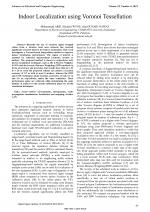| 4/2018 - 10 |
Indoor Localization using Voronoi TessellationARIF, M. |
| Extra paper information in |
| Click to see author's profile in |
| Download PDF |
Author keywords
indoor environments, interpolation, radio propagation, simultaneous localization and mapping, wireless LAN
References keywords
systems(10), location(9), indoor(9), localization(7), positioning(6), services(5), voronoi(4), information(4)
Blue keywords are present in both the references section and the paper title.
About this article
Date of Publication: 2018-11-30
Volume 18, Issue 4, Year 2018, On page(s): 85 - 90
ISSN: 1582-7445, e-ISSN: 1844-7600
Digital Object Identifier: 10.4316/AECE.2018.04010
Web of Science Accession Number: 000451843400010
SCOPUS ID: 85058775391
Abstract
Recently the use of received signal strength values from a wireless local area network has received significant research interest for indoor localization. This work investigates a Voronoi-based interpolation method to improve indoor localization performance. The region of interest is spanned by reference measurement locations, termed as anchors. The proposed method is shown to outperform well-known localization techniques such as the k-Nearest Neighbor (k-NN) and the Inverse Distance Weighting (IDW) methods in terms of accuracy and precision. Our results show that for a 20 m x 20 m room the proposed scheme can achieve a location accuracy of 5.7 m with at most 5 anchors, whereas the IDW and k-NN techniques attain location accuracies of only 6.1 m and 6.5 m, respectively, under the same conditions. These performance gains are achieved while maintaining the same number of anchors in the system calibration phase for all the considered techniques. |
| References | | | Cited By |
Web of Science® Times Cited: 4 [View]
View record in Web of Science® [View]
View Related Records® [View]
Updated 3 days, 4 hours ago
SCOPUS® Times Cited: 6
View record in SCOPUS® [Free preview]
View citations in SCOPUS® [Free preview]
[1] A Voronoi Diagram-Based Grouping Test Localization Scheme in Wireless Sensor Networks, Li, Guangming, Xu, Menghui, Teng, Gaofei, Yang, Wei, Mak, Shu-Lun, Li, Chun-Yin, Lee, Chi-Chung, Electronics, ISSN 2079-9292, Issue 18, Volume 11, 2022.
Digital Object Identifier: 10.3390/electronics11182961 [CrossRef]
[2] Formal estimation of wireless network services for signal strength and electromagnetic wave association in an International Green University, Fan, Yang-Hsin, Scientific Reports, ISSN 2045-2322, Issue 1, Volume 14, 2024.
Digital Object Identifier: 10.1038/s41598-024-71681-z [CrossRef]
[3] The Methodology of Creating Variable Resolution Maps Based on the Example of Passability Maps, Pokonieczny, Krzysztof, ISPRS International Journal of Geo-Information, ISSN 2220-9964, Issue 12, Volume 9, 2020.
Digital Object Identifier: 10.3390/ijgi9120738 [CrossRef]
[4] Recent advances in vision-based indoor navigation: A systematic literature review, Khan, Dawar, Cheng, Zhanglin, Uchiyama, Hideaki, Ali, Sikandar, Asshad, Muhammad, Kiyokawa, Kiyoshi, Computers & Graphics, ISSN 0097-8493, Issue , 2022.
Digital Object Identifier: 10.1016/j.cag.2022.03.005 [CrossRef]
[5] A Voronoi Diagram-Based Grouping Test Localization Scheme in Wireless Sensor Networks, Xu, Menghui, Li, Guangming, 2019 IEEE 19th International Conference on Communication Technology (ICCT), ISBN 978-1-7281-0535-2, 2019.
Digital Object Identifier: 10.1109/ICCT46805.2019.8947133 [CrossRef]
Disclaimer: All information displayed above was retrieved by using remote connections to respective databases. For the best user experience, we update all data by using background processes, and use caches in order to reduce the load on the servers we retrieve the information from. As we have no control on the availability of the database servers and sometimes the Internet connectivity may be affected, we do not guarantee the information is correct or complete. For the most accurate data, please always consult the database sites directly. Some external links require authentication or an institutional subscription.
Web of Science® is a registered trademark of Clarivate Analytics, Scopus® is a registered trademark of Elsevier B.V., other product names, company names, brand names, trademarks and logos are the property of their respective owners.
Faculty of Electrical Engineering and Computer Science
Stefan cel Mare University of Suceava, Romania
All rights reserved: Advances in Electrical and Computer Engineering is a registered trademark of the Stefan cel Mare University of Suceava. No part of this publication may be reproduced, stored in a retrieval system, photocopied, recorded or archived, without the written permission from the Editor. When authors submit their papers for publication, they agree that the copyright for their article be transferred to the Faculty of Electrical Engineering and Computer Science, Stefan cel Mare University of Suceava, Romania, if and only if the articles are accepted for publication. The copyright covers the exclusive rights to reproduce and distribute the article, including reprints and translations.
Permission for other use: The copyright owner's consent does not extend to copying for general distribution, for promotion, for creating new works, or for resale. Specific written permission must be obtained from the Editor for such copying. Direct linking to files hosted on this website is strictly prohibited.
Disclaimer: Whilst every effort is made by the publishers and editorial board to see that no inaccurate or misleading data, opinions or statements appear in this journal, they wish to make it clear that all information and opinions formulated in the articles, as well as linguistic accuracy, are the sole responsibility of the author.





